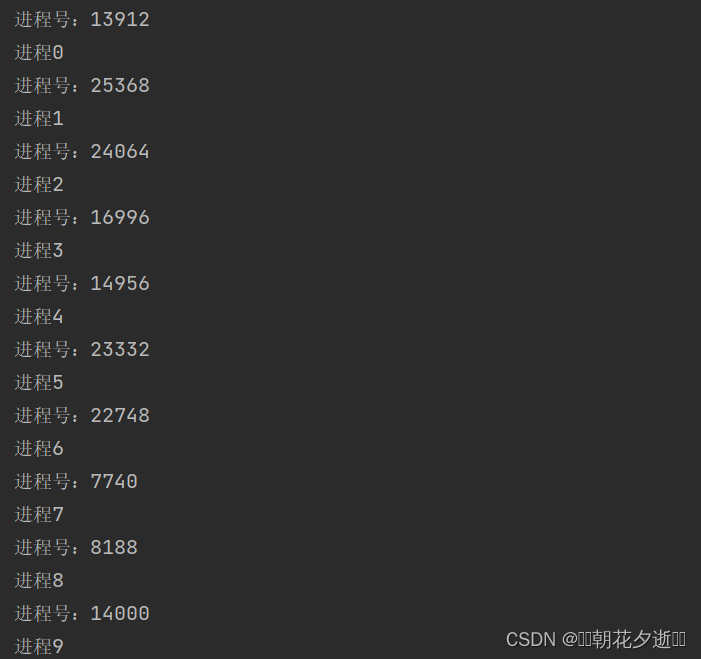池的介绍:
提前创建进程池,防止创建的进程数量过多导致系统性能受到影响,在系统执行任务时,系统会使用池中已经创建进程/线程,从而防止资源的浪费,创建的进程/线程可以让多个进程使用,从而降低了操作系统的负担,加快了系统执行的效率;
若果不创建进程池,可能会导致任务建立的进程数量过多,影响系统,并且在执行不同任务时,还会重新进行进程的创建,导致资源的浪费
池的使用:
进程池:
ProcessPoolExecutor
进程池的使用:
from threading import current_thread
from concurrent.futures import ThreadPoolExecutor,ProcessPoolExecutor
def func(i):
print("进程号:{}\n".format(current_thread().ident))
print("进程{}\n".format(i))
tp = ThreadPoolExecutor(4)
ts = ProcessPoolExecutor(10)
if __name__ == '__main__':
for i in range(100):
tp.submit(func,i)
运行结果:
 由于此时池中创建了四个进程,因此函数func()在执行多次的过程中会循环的使用四个已经创建的进程(如上图)
由于此时池中创建了四个进程,因此函数func()在执行多次的过程中会循环的使用四个已经创建的进程(如上图)
不使用进程池:
from threading import current_thread
from multiprocessing import Process
def func(i):
print("进程号:{}".format(current_thread().ident))
print("进程{}".format(i))
if __name__ == '__main__':
for i in range(10):
t = Process(target=func,args=(i,)).start()
运行结果:

两者对比可以看到,由于后者未使用进程池,因此,在func()函数执行了10次时,系统创建了十个进程,而前者使用了建立了四个进程的进程池,因此,即使func()函数执行了100次,系统也只创建了4个进程
线程池:
不使用线程池:
from threading import current_thread
from threading import Thread
def func(i):
print("线程号:{}".format(current_thread().ident))
if __name__ == '__main__':
for i in range(10):
t = Thread(target=func,args=(i,)).start()
运行结果:

有结果可以看到:使用线程运行了十次func()函数,系统创建了十个进程用来执行此任务
使用线程池:
from threading import current_thread
from concurrent.futures import ThreadPoolExecutor
def func(i):
print("线程号:{}".format(current_thread().ident))
if __name__ == '__main__':
tp = ThreadPoolExecutor(20)
for i in range(100):
tp.submit(func,i)
运行结果:
 执行100次,但是被使用的线程仅有创建的20个,节省了系统的资源
执行100次,但是被使用的线程仅有创建的20个,节省了系统的资源
使用map()方法进行函数的传递
from threading import current_thread
from concurrent.futures import ThreadPoolExecutor
def func(i):
print("线程号:{}".format(current_thread().ident))
print(i)
if __name__ == '__main__':
tp = ThreadPoolExecutor(4)
ret = tp.map(func,(i for i in range(10)))
print(ret)
回调函数:
from threading import current_thread
from concurrent.futures import ThreadPoolExecutor
def func(i):
print("线程号:{}".format(current_thread().ident))
print(i)
return i**2
def print_func(ret,i):
print("我是print_func()函数")
print(ret.result())
if __name__ == '__main__':
tp = ThreadPoolExecutor(4)
for i in range(20):
ret = tp.submit(func,i)
ret.add_done_callback(print_func)
运行结果:
使用回调函数可以保证ret对象在执行完毕之后立即执行回调函数的参数对象
进程创建数量的建议:
进程数量:建议进程数量为cpu数量的一倍 到cpu数量的二倍之间
线程数量:建议线程数量为cpu数量的五倍
猜你喜欢
网友评论
- 搜索
- 最新文章
- 热门文章
